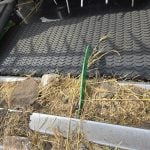A Saskatchewan farmer with an interest in experimentation is testing how a host of crops can be seeded with the same implement. Keith Bacon, who farms six kilometres north of Ogema in south-central Saskatchewan, is testing 24 crops, all seeded with a John Deere 9350 hoe drill. Garry Noble, a Saskatchewan Agriculture extension agrologist at […] Read more
Stories by Saskatchewan Agriculture
Look out for silvertop in grass seeds
One of the most mysterious and potentially damaging problems of grass being grown for seed is silvertop. Perhaps the worst aspect is that by the time symptoms are evident, it’s too late to salvage the crop. “Silvertop symptoms are distinctive and become apparent when the seed stalk elongates to develop seed heads,” said Michel Tremblay, […] Read more
Act quickly if crop protection products fail
Producers have become accustomed to their crop protection products working well. When something goes wrong, they get nervous. They can’t afford a failure with these products, especially with tight farm margins. “While manufacturers are generally very good about standing behind their products, they also need solid evidence that their product didn’t perform,” said Clark Brenzil, […] Read more
Scentless chamomile should be pulled out, bagged and burned.
Scentless chamomile, a noxious weed that grows as an annual, winter annual and sometimes as a perennial, is a serious threat to agriculture, especially during years of above-normal precipitation, says Garry Bowes, co-ordinator of the Integrated Noxious Weed Management Program in Saskatoon. “In a series of experimental plots, the summer annual growth form of scentless […] Read more
Take precautions against powdery mildew infestation
Powdery mildew on dry peas poses a significant risk again this year due to late seeding, says Ray McVicar, special crops specialist with Saskatchewan Agriculture. “Powdery mildew can reduce yield, delay maturity and make it difficult to do a proper job of desiccating the crop,” he said. The symptoms of powdery mildew first appear in […] Read more
Nutritional benefit of chaff studied
Farmers who want to use crop residues as feed should consider chaff, which is suitable for a beef cow herd, said Murray Feist, a livestock agrologist with Saskatchewan Agriculture. The department’s publication FarmFacts Chaff: Ammoniation, Nutrition and Feeding offers detailed information on this alternative feed. The guide was recently updated by Feist and Lyle Darwent, […] Read more
Care essential to prevent toxins forming in sweet clover
The weather that has provided perfect growing conditions for forages in many areas this year is also causing concern about hay and silage conditions, especially for sweet clover. “Sweet clover is notorious for taking extra time to dry due to its succulent stem,” said Bob Klemmer, livestock agrologist with Saskatchewan Agriculture in Weyburn. Add to […] Read more
Honey bees face beetle
The African small hive beetle has left a slimy, foul-smelling trail from the beehives of Florida to, most recently, those of Minnesota. Whether that trail will extend into Canada remains to be seen, says John Gruszka of Prince Albert, Sask.. He is Saskatchewan Agriculture’s provincial apiculturist. “It’s just a waiting game,” he said. “Our one […] Read more
Website provides pulse disease info
A new website provides information on diseases that afflict lentils, peas and chickpeas. This information includes text and color photographs that identify the diseases, guidelines for determining whether fungicide treatment is necessary, and maps that indicate the Saskatchewan rural municipalities in which the diseases are occurring. Called Pulse Crop Diseases, the site can also be […] Read more
Carefully consider forage mixtures
Convenience often exacts a price. Pre-mixed forage-seed combinations would seem to eliminate the need for planning or research on the part of producers, but the results of seeding such mixes can be disappointing and costly. The forage specialist with Saskatchewan Agriculture urges producers to design their own seed mix to reflect forage needs and growing […] Read more



